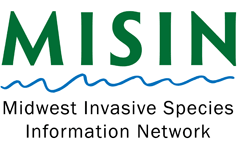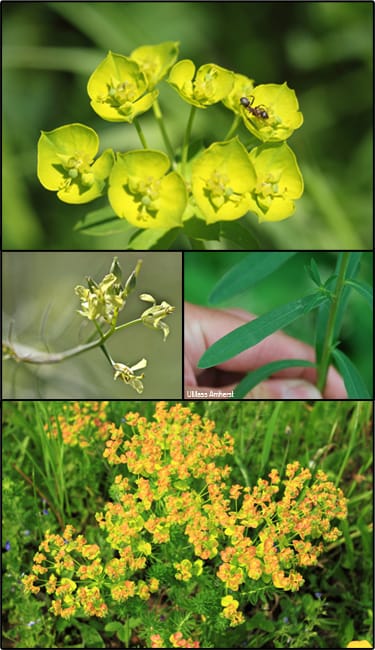|
Leafy Spurge (Euphorbia esula)
Introduced to North America from Central Europe in the 1820s, likely mixed in with desired imported seeds.
What problems does leafy spurge cause? Like most invasive plants, leafy spurge replaces native plants in high quality natural areas, which in turn reduces critical food resources for birds, butterflies, and other wild creatures. Leafy spurge is especially problematic in pasture areas, as it is poisonous to livestock, though goats appear immune to the toxins and can graze without harm. Leafy spurge’s extensive root system allows it to spread quickly and take much of the available water and nutrients needed by native plants. Additionally, leafy spurge can secrete toxins into the soil that slow or stop native plant growth. What does leafy spurge look like? Leafy spurge typically grows 2-3 ft tall (young plants may be much shorter), often with many shoots spreading from an underground woody crown. In heavily invaded areas, there may be as many as 200 stems in one square yard! The leaves are very thin and lance-like; stems and leaves both exude a milky white sap (latex) when cut. Leafy spurge flowers bloom from May to late June and are small and yellow-green—more notable are the paired yellow “bracts” (leaves that look like petals) that back the flowers. Many flowers are loosely clustered together at the top of a shoot in an arrangement called an “umbel,” which looks like a flat umbrella. How do I manage leafy spurge? Prevent invasions by restoring degraded areas like old fields or roadsides back to native plants. This helps prevent invasive plants from forming monocultures by increasing resource competition. If you’re managing existing spurge populations, develop a management plan that includes surveys so that you can ensure you’re best prioritizing control efforts. Leafy spurge’s massive root system and tendency to re-sprout makes it nearly impossible to remove by pulling or cutting, though a small patch that is checked regularly for several years could be managed physically. Mowing is to be avoided; breaking leafy spurge stems releases the toxic sap, which can cause irritation or worse for native wildlife, pets, and even people. In order to be most effective, a slow-acting, systemic herbicide may be used before seeds mature, or in the fall before the plant goes into winter dormancy. You can find very thorough treatment instructions using the Midwest Invasive Plant Network (MIPN) control database (http://mipncontroldatabase.wisc.edu/). |
|
| habitatmatters.org |
Contact US231-252-4148
3334 Veterans Drive Unit A Traverse City, Michigan 49685 |
Pleasant Peninsula Design, Habitat Matters 2017



